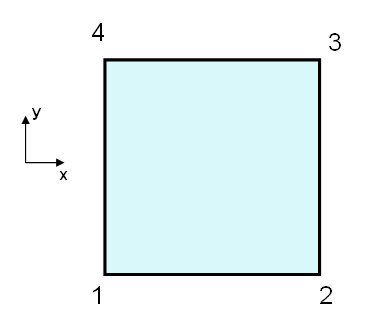Users:General FEM Analysis/Elements Reference/Quad1
From Carat++ Public Wiki
< Users:General FEM Analysis | Elements Reference(Difference between revisions)
(→Degrees of Freedom) |
(→Example of a Complete Input Block) |
||
| (6 intermediate revisions by one user not shown) | |||
| Line 4: | Line 4: | ||
== General Description == | == General Description == | ||
| − | + | [[File:Quad.PNG|300px|center|4-noded quad element]] | |
=== Element Type === | === Element Type === | ||
| − | This class provides a purely displacement formulated four-noded plane stress/plane strain element. '''It is | + | This class provides a purely displacement formulated four-noded plane stress/plane strain element. '''It is intended for comparisons and introductory purpose only'''. The element is only able to perform geometrically linear static computations and cannot carry element loads. |
=== Degrees of Freedom === | === Degrees of Freedom === | ||
| Line 29: | Line 29: | ||
|Linking to a material input block | |Linking to a material input block | ||
|- | |- | ||
| − | ! | + | !THICKNESS |
| − | | | + | |''real'' |
| − | | | + | |Parameter for constant element thickness |
| − | + | ||
|- | |- | ||
| − | | | + | !INT_TYPE_QUAD |
| + | |FULL | ||
| + | |Only full integration is available | ||
|- | |- | ||
| − | ! | + | !MODE |
| − | + | |PSTRESS, PSRTAIN | |
| − | + | |Switch to choose plane stress or plane strain computation | |
| − | | | + | |
| − | + | ||
| − | + | ||
| − | + | ||
| − | + | ||
| − | + | ||
| − | + | ||
| − | + | ||
| − | + | ||
| − | + | ||
|- | |- | ||
|} | |} | ||
| Line 55: | Line 46: | ||
=== Example of a Complete Input Block === | === Example of a Complete Input Block === | ||
<pre> | <pre> | ||
| − | EL-PROP 1: | + | EL-PROP 1: QUAD1 |
MAT = EL-MAT 1 | MAT = EL-MAT 1 | ||
| − | + | THICKNESS = 0.1 | |
| − | EAS = | + | INT_TYPE_QUAD = FULL |
| + | EAS = PSTRESS ! choose: PSTRESS, PSTRAIN | ||
</pre> | </pre> | ||
| − | |||
<pre> | <pre> | ||
| − | ! ElementID Part-ID EL-PROP | + | ! ElementID Part-ID EL-PROP Node-IDs |
| − | NEL 1 1 1 1 2 3 4 | + | NEL 1 1 1 1 2 3 4 |
| − | + | ||
| − | + | ||
</pre> | </pre> | ||
| − | |||
| − | |||
| − | |||
| − | |||
| − | |||
| − | |||
| − | |||
| − | |||
| − | |||
| − | |||
| − | |||
| − | |||
| − | |||
| − | |||
| − | |||
| − | |||
| − | |||
| − | |||
| − | |||
| − | |||
| − | |||
| − | |||
| − | |||
| − | |||
| − | |||
| − | |||
| − | |||
| − | |||
| − | |||
| − | |||
| − | |||
| − | |||
| − | |||
| − | |||
| − | |||
| − | |||
| − | |||
| − | |||
| − | |||
| − | |||
| − | |||
| − | |||
| − | |||
| − | |||
| − | |||
| − | |||
| − | |||
| − | |||
| − | |||
| − | |||
| − | |||
| − | |||
| − | |||
| − | |||
| − | |||
| − | |||
| − | |||
| − | |||
| − | |||
| − | |||
== References == | == References == | ||
<references/> | <references/> | ||
Latest revision as of 07:24, 7 September 2010
Contents |
General Description
Element Type
This class provides a purely displacement formulated four-noded plane stress/plane strain element. It is intended for comparisons and introductory purpose only. The element is only able to perform geometrically linear static computations and cannot carry element loads.
Degrees of Freedom
All nodes of the plane stress/stain element have to be defined in the plane z=0 and all movements take place in this plane. So nodal displacements can be described by the two remaining translatoric degrees of freedom, Disp_X and Disp_Y.
Input Parameters
Parameter Description
| Compulsory Parameters | ||
| Parameter | Values, Default(*) | Description |
|---|---|---|
| MAT | EL-MAT int | Linking to a material input block |
| THICKNESS | real | Parameter for constant element thickness |
| INT_TYPE_QUAD | FULL | Only full integration is available |
| MODE | PSTRESS, PSRTAIN | Switch to choose plane stress or plane strain computation |
Example of a Complete Input Block
EL-PROP 1: QUAD1 MAT = EL-MAT 1 THICKNESS = 0.1 INT_TYPE_QUAD = FULL EAS = PSTRESS ! choose: PSTRESS, PSTRAIN
! ElementID Part-ID EL-PROP Node-IDs NEL 1 1 1 1 2 3 4
References
| Whos here now: Members 0 Guests 0 Bots & Crawlers 1 |
